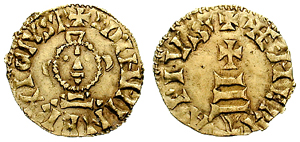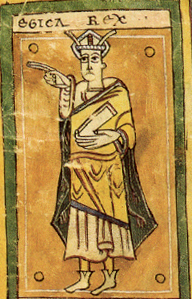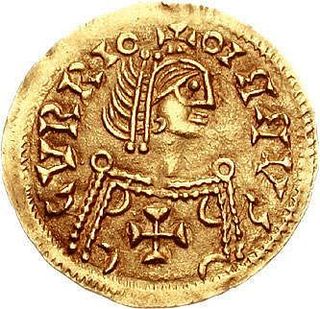Related Research Articles

Pedro González de Mendoza was a Spanish cardinal, statesman and lawyer. He served on the council of King Enrique IV of Castile and in 1467 fought for him at the Second Battle of Olmedo. In 1468 he was named bishop of Sigüenza and in 1473 he became cardinal and archbishop of Seville and appointed chancellor of Castile.

Reccared I was Visigothic King of Hispania and Septimania. His reign marked a climactic shift in history, with the king's renunciation of Arianism in favour of Roman Christianity in 587.
Iria Flavia or simply Iria in Galicia, northwestern Spain, is an Ancient settlement and former bishopric in the modern municipality of Padrón, which remains a Catholic titular see.

The Revolt of the Comuneros was an uprising by citizens of Castile against the rule of Charles I and his administration between 1520 and 1521. At its height, the rebels controlled the heart of Castile, ruling the cities of Valladolid, Tordesillas, and Toledo.

Sisenand was a Visigothic King of Hispania, Septimania and Galicia from 631 to 636.

Wamba was the king of the Visigoths from 672 to 680. During his reign, the Visigothic kingdom encompassed all of Hispania and part of southern Gaul known as Septimania.

Erwig was a king of the Visigoths in Hispania (680–687).

Wittiza was the Visigothic King of Hispania from 694 until his death, co-ruling with his father, Egica, until 702 or 703.

Egica, Ergica, or Egicca (c. 610 – 701/703), was the Visigoth King of Hispania and Septimania from 687 until his death. He was the son of Ariberga and the brother-in-law of Wamba.
Julian of Toledo (642–690) was born in Toledo, Hispania. He was well educated at the cathedral school, was a monk and later abbot at Agali, a spiritual student of Saint Eugene II, and archbishop of Toledo. He was the first bishop to have primacy over the entire Iberian Peninsula—a position he has been accused of securing by being complicit in 680 in the supposed poisoning of Wamba, king of the Visigoths—and he helped centralize the Iberian Church in Toledo. His elevation to the position of primate of the Visigothic church was a source of great unhappiness among the kingdom's clergy. And his views regarding the doctrine of the Trinity proved distressing to the Vatican.
Paulus or Paul was a 7th-century Roman general in service of the Visigothic Kingdom. In 673, Paulus accompanied the Visigothic king Wamba on a campaign against the Basques, but when news reached them of a revolt led by the count Hilderic in Septimania, the northernmost and easternmost province of the kingdom, Paulus was dispatched with a considerable contingent of troops to put down the rebellion. Upon arrival in Septimania, Paulus not only completely disregarded his mission, but made himself the leader of the rebels and was anointed as king. Paulus managed to cement his authority over Septimania and the neighbouring province of Tarraconensis through the size of his army, and possibly through the two provinces being among the last properly Romanised regions of the kingdom. Titling himself as 'king of the east', Paulus ruled from Narbonne and sought to break away from Visigothic central control.
The Fifteenth Council of Toledo first met in Toledo, Spain on 11 May 688 under Visigothic King Egica. It was the first of his three councils.
The Fourteenth Council of Toledo first met in Toledo, Spain, on 14 November 684 under Visigothic King Erwig. It was called in response to a letter from Pope Leo II directing the king, a Count Simplicius, and the recently deceased Quiricus, metropolitan of Toledo, to call a general council to confirm the decisions of the ecumenical Third Council of Constantinople against monothelitism.
The Sixteenth Council of Toledo first met in Toledo, Spain on 25 April 693. It was the second of three councils convened by Visigothic king Egica.

Fructuosus of Braga was the Bishop of Dumio and Archbishop of Braga, a great founder of monasteries, who died on 16 April 665. He was the son of a Visigothic dux in the region of Bierzo and at a young age accompanied his father on official trips over his estates. After a period spent as a hermit, he established a monastery at Complutum and became its first abbot.
The Tenth Council of Toledo was summoned to meet in Toledo on 1 December 656 by King Reccesuinth of Hispania.
The Twelfth Council of Toledo, held in Toledo, Spain, was initiated on 9 January 681 by the Visigothic King Erwig, who was elected king in 680. One of its first actions was to release the population from the laws of Wamba and recognise Erwig, anathematising all who opposed him.
The Eighth Council of Toledo commenced on 16 December 653 in the church of the Holy Apostles in Toledo in Spain. It was attended by fifty two bishops in person, including the aged Gavinio of Calahorra, who had assisted at the Fourth Council, and another ten by delegation, ten abbots, and the archpriest and primicerius of the cathedral. Also, for the first time, secular officials, sixteen counts palatine, participated in the discussion, voting, and affirmation of the council's acts.

The Visigothic Kingdom, Visigothic Spain or Kingdom of the Goths, was a kingdom that occupied what is now southwestern France and the Iberian Peninsula from the 5th to the 8th centuries. One of the Germanic successor states to the Western Roman Empire, it was originally created by the settlement of the Visigoths under King Wallia in the province of Gallia Aquitania in southwest Gaul by the Roman government and then extended by conquest over all of Hispania. The Kingdom maintained independence from the Eastern Roman or Byzantine Empire, whose attempts to re-establish Roman authority in Hispania were only partially successful and short-lived.

Toledo is the repository of more than 2000 years of history. Successively a Roman municipium, the capital of the Visigothic Kingdom, a fortress of the Emirate of Cordoba, an outpost of the Christian Kingdom, and in the 16th century, the temporary seat of supreme power under Charles V. Its many works of art and architecture are the product of three major religions – Judaism, Christianity and Islam.
References
- ↑ "The Power of the Pope During the Middle Ages" Google Books Retrieved 12 May 2012